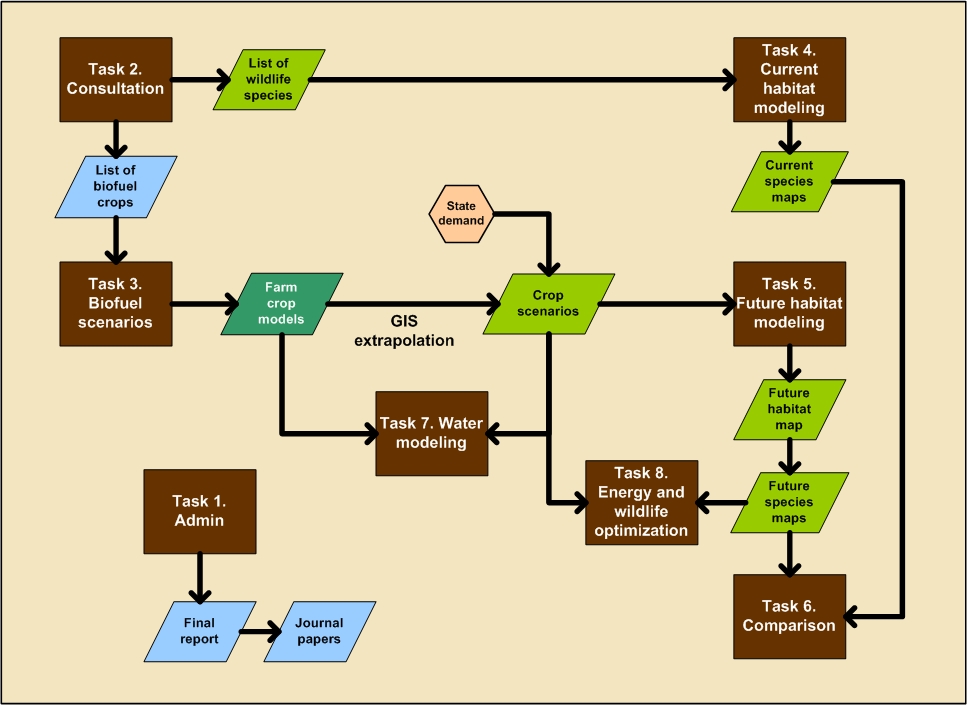
What's New
Research & Projects Publications
People
Data
Links
UCSB Biogeography Laboratory Projects
Biofuels and Biodiversity in California
Principal Investigator: Dr. Frank Davis
Co-Principal Investigators: Dr. David Stoms, Dr. Stephen Kaffka (UC Davis)
Funding agency: California Energy Commission-PIER
Project period: January 1, 2009 to June 30, 2010
Project summary:
Problem Statement
Californiaís modest demand for biofuel is expected to drastically increase with the implementation of recently approved state policies. California requires a blend rate of 5.7 percent ethanol with fossil fuel in vehicles; however, itís possible for vehicles to use blend rates of 10 percent and 20 percent ethanol. Current annual usage of ethanol is approximately 1 billion gallons, with another 4 millions gallons of biodiesel (California Biomass Collaborative 2006). Currently, California imports more than 95 percent of the biofuels used in-state (California Energy Commission 2007). The Governorís Executive Order S-06-06 sets goals for increasing reliance on in-state production of biofuels, specifically that California should produce at least 20 percent of the biofuels consumed in the state by 2010, 40 percent by 2020, and 75 percent by 2050. Hundreds of thousands of acres would need to be dedicated to produce biofuel feedstocks to meet even the short-term goal for 2010 at the low blend rates for both ethanol and biodiesel. Land requirements would increase to millions of acres by 2050 for all blend rates.Nearly half of the terrestrial vertebrate species in California utilize the stateís agricultural lands, particularly those species with greater dispersal ability. Agricultural land tends to be more valuable for feeding and cover needs of these species than for reproduction. The continuing importance of the Central Valley as a major flyway for migratory birds illustrates this point. Even some threatened or endangered species can persist with modest set-asides in the working landscape. For instance, the San Joaquin kit fox can survive if its prey base is maintained and there are sufficient patches of untilled land for denning sites. Conversely, some species have been negatively affected by secondary environmental impacts of farm practices, such as the concentration of selenium in agricultural runoff from overwatering of certain soils.
Market forces for biofuel could make marginal and retired lands attractive for conversion to energy crops. Converting from current crops to some biofuel crops could reduce existing habitat impacts to the benefit of some species of concern. The habitat factors most likely to be altered include change in vegetation structure, water usage, pesticides, invasive species, and timing or method of cultivation and harvesting (such as whether corn stover is harvested for cellulose or tilled under to fertilize and stabilize the soil). For this project we will conduct a statewide study of the potential effects on habitat of wildlife species associated with changes in crops, crop patterns, and agricultural practices under several scenarios of biofuels production.
Research Questions
- Where in California might biofuel feedstocks be grown and which crop types in those locations if the state were to meet its energy targets with instate crops?
- How might distribution of wildlife species change in response to plausible scenarios of production of biofuel crops?
- What is the relative effect of the different biofuel crops on wildlife species? Which crops would likely have the greatest negative impact on wildlife species? Which has the least negative (or the greatest positive) impact?
- What locations in the state appear suitable for biofuel crop production with minimal negative impact on wildlife species?
- What are the implications on water use for the biofuel scenarios?
- Where could biofuel crop targets optimally be met with minimum impact on wildlife species and minimum water consumption?
Tasks
- Consult with experts about biofuel crops and about wildlife in agricultural landscapes. Which wildlife species are associated with agricultural habitats that should be included in the analysis? What species of special concern? Which habitat features are subject to change with conversion to biofuel crops and how might that change affect habitat suitability for wildlife? What data are needed to model these changes spatially and where can we obtain them?
- Develop scenarios of biofuel crop production. The UC Davis partners will be developing linear programming models of crop production at the farm-scale within each region of the state. The UCSB team will extrapolate that information across the state to create maps of potential feedstock production for different target levels.
- Model current distributions of selected wildlife species. For terrestrial vertebrate species associated with agricultural habitats in the state, apply the California Wildlife Habitat Relationships (CWHR) database, habitat mapping, and other spatial data to develop detailed maps of their current distribution. Our consultation with wildlife experts will provide details on the habitat features most important for improving and refining these species models over the existing CWHR models and for which data currently exist.
- Model future distributions of wildlife species based on the different biofuel crop scenarios.
- Compare the current and future distributions of species. Quantify the gains and losses and net change to identify which species are most at risk. Quantify the potential gains and losses at geographic locations to estimate the vulnerability of places to biofuel crop production.
- Model water use associated with the crop production in the biofuel crop scenarios. For each scenario, extrapolate water use from the linear programming models from UC Davis to all farmland with biofuel crops.
- Model biofuel crop production, wildlife impacts, and water use. This task will develop an optimization model that will allocate sufficient land to meet biofuel targets while minimizing wildlife impacts and/or water use.
Project Publications:

